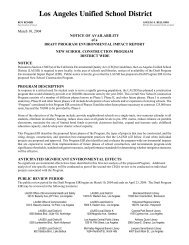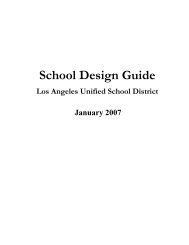Site-Specific Health and Safety Plan (HASP) - Laschools.org
Site-Specific Health and Safety Plan (HASP) - Laschools.org
Site-Specific Health and Safety Plan (HASP) - Laschools.org
Create successful ePaper yourself
Turn your PDF publications into a flip-book with our unique Google optimized e-Paper software.
the reported SQLs take into account sample characteristics <strong>and</strong> analytical adjustments,<br />
they are the most relevant quantitation limits for evaluating nondetected chemicals.<br />
6.2.3 Detection Limit Goals<br />
To define analytical data reporting limits that meet project DQOs, potential risk-based<br />
screening criteria were identified. Risk-based preliminary remediation goals (PRGs) for<br />
residential soil, California <strong>and</strong> Federal MCLs <strong>and</strong> tap water PRGs were reviewed to<br />
identify potential action levels that may be applicable to the site <strong>and</strong> achievable by the<br />
laboratory. PQLs supplied by the laboratory are compared against Table 6-2 action<br />
levels. PQLs for vapor analysis (TO-15) are supplied in Table 6-3. Since soil gas<br />
samples will be analyzed by TO-15, screening criteria are not appropriate <strong>and</strong> will not be<br />
included in Table 6-3.<br />
6.2.4 Practical Quantitation Limit<br />
The practical quantitation limits are the lowest matrix-specific concentrations that can be<br />
reliably achieved within specified limits of precision <strong>and</strong> accuracy during routine<br />
laboratory operating conditions. All sample results will be reported at or above the MDL<br />
for each analyte. All results above the MDL, but below the PQL, will be qualified in the<br />
data deliverable from the laboratory with a “J” flag. The “J” flag will denote the sample<br />
result as below the PQL. Where practical, MDLs must be lower than the risk-based<br />
criteria determined for the project. Laboratories must verify the PQLs by analyzing a<br />
st<strong>and</strong>ard at or below the PQL when performing the initial calibration curve.<br />
Reporting limits are the lowest reported concentration provided on the sample-analysis<br />
data report, after corrections have been made for sample dilution, sample weight, <strong>and</strong> (for<br />
soils <strong>and</strong> sedimnts) amount of moisture in the sample. Reporting limits can be as low as<br />
the MDL or exceed the PDL, depending on the matrix effects encountered during the<br />
analysis. The reporting limit is the value that indicates whether the analytical DQOs<br />
have been achieved for that sample.<br />
6-3<br />
K:\Depts\Dept48\LAUSD\MSA WORK\QAPP\Draft Final QAPP to DTSC\QAPP for OU 1 RAP.DOC<br />
304







